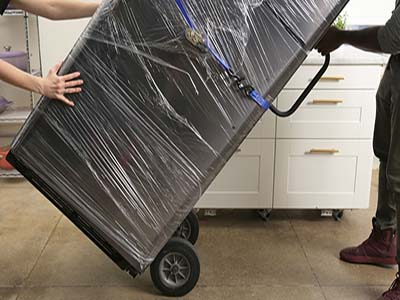Factors Affecting Refrigerator Weight
One of the most important factors that affect the weight of a refrigerator is its size and storage capacity. Larger refrigerators, which can hold more food and drinks, naturally weigh more than their smaller counterparts. As you might expect, a spacious French door refrigerator is heavier than a compact mini refrigerator.
The type of refrigerator also plays an important role in its weight. Common refrigerator types include top freezer, side-by-side, and French door models.. Each type has its unique design and features, which can contribute to variations in weight.
Modern refrigerators come with a range of features such as ice makers, water dispensers and smart technology. These additional components and technologies can increase the weight of the device.
Average Weights by Refrigerator Type
To give you a better idea of what to expect, here are the average weight ranges for different refrigerator types:
- Top Freezer Refrigerators: Typically weigh between 150 and 250 pounds.
- Side-by-side refrigerators: Generally weigh between 113 and 159 kilograms.
- French door refrigerators: Their average weight is between 113 and 204 kilograms.
- Mini refrigerators and compact refrigerators: Lighter options weighing between 14 and 45 kilograms

Determining Your Refrigerator’s Weight
Determining the Weight of Your Refrigerator The most accurate way to determine the weight of your specific refrigerator is to check the manufacturer’s specifications. You can often find these in the user manual or on the manufacturer’s website. Simply search for your fridge’s model number to access this information.
For smaller refrigerators that can be safely lifted, you can measure the weight using a household scale. Place the scale on a flat, level surface, then carefully lift the refrigerator and place it on the scale. Be sure to distribute the weight evenly to get an accurate reading.
Moving Your Fridge: Safety and Tips
Moving a refrigerator can be a daunting task due to its weight and size. To ensure a safe and successful move, consider these safety tips and practical advice:
1. Gather Your Supplies
Before you begin, gather the necessary supplies:
- Appliance dolly: A sturdy dolly for transporting heavy equipment is essential.
- Moving straps: These help to attach the refrigerator to the transport trolley
- Furniture sliders: Useful for moving the refrigerator over smooth surfaces
- Tape and plastic bags: Use tape to secure loose items in the refrigerator and plastic bags for small items
- Blankets or padding: Protect the refrigerator from scratches and dents during the move.
2. Empty and Clean the Fridge
Remove all items from the refrigerator and freezer. Dispose of perishables or plan to use a cooler for temporary storage. Clean and defrost the freezer when necessary, as a clean refrigerator is lighter and easier to transport.
3. Disconnect the Fridge
Unplug the refrigerator and, if necessary, turn off the water supply. Coil the power cord and secure it with tape to prevent tripping hazards.

4. Secure Loose Parts
Remove all removable shelves, drawers, and accessories from the refrigerator and wrap them in blankets or bubble wrap. Secure these items in the refrigerator to keep them in place during transport.
5. Tilt and Slide
With the help of a friend or mover, gently tilt the refrigerator backward and place furniture sliders underneath. This makes it easier to slide the fridge to its new location without damaging your floors.
Use Proper Lifting Techniques
When lifting the refrigerator onto the cart or moving it up or down stairs, use appropriate lifting techniques:
- End your knees and keep your back straight.
- Use your legs, not your back, to lift.
- Maintain a firm grip on the refrigerator and control the weight.
7. Secure the Fridge
Use moving straps to secure the refrigerator to the dolly. Ensure it’s stable and won’t tip over during transport.
8. Clear Pathways
Clear the path of obstacles, tripping hazards, and potential obstructions between the current and new location of the fridge.

9. Move Slowly and Carefully
Move the refrigerator slowly and carefully to prevent sudden shifts or bumps. If you encounter stairs, take your time and enlist help to navigate them safely.
10. Level the Fridge
Once the refrigerator is in its new location, use a level to ensure it sits evenly. Adjust the leveling feet or rollers if needed to prevent wobbling.
11. Let it Settle
Allow the refrigerator to rest for a few hours before plugging it in. This allows any refrigerant liquid to settle and ensures proper cooling. Safely moving a refrigerator requires planning, teamwork, and the right equipment.
By following these safety tips and practical steps, you can move your refrigerator without risking injury or damage to the appliance.Common Questions About Fridge Weight
Common Questions About Fridge Weight
Now it’s time to revise Common questions, such as whether a refrigerator’s weight includes the food and items stored inside it and if a refrigerator’s weight changes over time.
1. How much does an average refrigerator weigh?
- The weight of an average refrigerator typically ranges from 200 to 400 pounds (90 to 180 kilograms). However, the weight can vary significantly depending on the size, type, and features of the refrigerator.
2. Do refrigerator weights include the packaging?
- No, the weight of a refrigerator usually refers to the appliance’s weight alone and does not include the packaging or any additional accessories.
3. How can I find the weight of my specific refrigerator model?
- You can usually find the weight of your refrigerator in the owner’s manual or on the manufacturer’s website. If this information is not readily available, you can contact the manufacturer’s customer support for assistance.
4. Does the weight of a refrigerator affect its energy efficiency?
- The weight of a refrigerator does not directly impact its energy efficiency. Energy efficiency is determined by the appliance’s design, insulation, and components. However, a heavier refrigerator may be more challenging to move and install, so proper placement and leveling are crucial for efficient operation.
5. Are there any safety considerations when moving a heavy refrigerator?
- Yes, moving a heavy refrigerator can be challenging and potentially dangerous. It’s essential to use proper lifting techniques, secure the refrigerator during transport, and avoid tipping it over. It’s often recommended to have assistance or professional movers when relocating a heavy appliance.
6. Can a floor support the weight of a refrigerator?
- Most standard floors can support the weight of a refrigerator without issues. However, it’s advisable to check the floor’s load-bearing capacity, especially if you have concerns about placing a heavy refrigerator on an upper level of your home.
7. Are there weight limitations for built-in refrigerators?
- Built-in refrigerators are typically designed to fit seamlessly into cabinetry and may have specific weight limitations specified by the manufacturer. It’s crucial to adhere to these limitations to ensure proper installation and operation.
8. Do different types of refrigerators have different weights?
- Yes, the weight of a refrigerator can vary depending on the type. For example, compact or mini refrigerators are lighter than large refrigerators. Additionally, side-by-side and French door refrigerators tend to be heavier than top freezer models due to their larger size and features.
These frequently asked questions provide insight into the weight considerations associated with refrigerators and help consumers make informed decisions about installation, transportation, and usage.